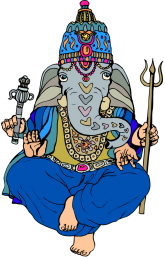
New Delhi, Oct 22 (IANS) — “The demand has grown exponentially since last year and people are finding it more attractive than the Indian-made idols,” Sharad Goyal of Kriti Creations, a shop in south Delhi’s Khan Market, told IANS.
In the last one week the shop has sold more than 50-60 idols of Ganesha and Lakshmi, which Goyal says has meant an increase of 30 percent in profits from a year ago.
Across the city, depending on their size, raw materials used and markets one goes to, the price of a pair of Ganesha and Lakshmi ranges from Rs.40 to as high as Rs.2,000.
“Most of them illegally enter the Indian market, thanks to a strong network and distribution channel,” said Bikky Khosla, chief executive of tradeindia.com, a leading B2B portal.
“The idol making industry is a huge market. So it is quite natural for Chinese businessmen to take advantage of this tremendous money-making potential,” Khosla stressed.
The usual practice of Chinese manufacturers is to send an expert team to study the Indian market and understand the current trends, especially during the festive season. Armed with the knowledge, they produce in China in bulk what the Indians are looking for, with slight innovations and export them through various channels to this country with a cheaper price tag.
The figurines are made of papier mache, fibre glass and porcelain. All the idols are machine made, in contrast to the Indian counterparts that are more often than not hand crafted.
Said Arpana Singh, a young housewife: “The Chinese-made goods are much neater and shinier as they are moulded. People often prefer them as they are cheap and good for decorative purposes. But they are of doubtful quality.”
Khosla said: “This huge influx of Chinese goods have killed almost 60 percent of our cottage industry. However, in this age of globalisation we cannot run away from these issues but we need to empower our artisans and give them proper training.”
The fact that a Communist nation that has no organized religion has no compunction about making Hindu gods to further business prospects is typical of the pragmatism that governs its economic philosophy and has made it one of the world’s top trading nations.
Chinese-made firecrackers, lights and toys have flooded the Indian market for the past few years and the gods could not have been far behind once they realized that there is money to be made from the vast untapped consumer market beyond the high-end white goods and luxury products.
T.S. Vishwanath, a China expert of the Confederation of Indian Industry (CII), told IANS: “Communism or atheism has nothing to do with it. There is a huge market opportunity they are taking advantage of. They did the same thing with silk saris. They have well-planned channels to market their products.”
Echoes Sunil Sinha, a senior economist at CRISIL: “China is our third largest trading partner. Far from being sceptical about their trading practices, our entrepreneurs should try to learn from the way they first study the market and then do mass production to suit that market. That is their USP; that is why they are able to price their products so competitively.
Lalit Kumar Das, a Kolkata-based idol-maker, said: “Earlier the money I used to make during these festivals by making idols was enough for me to support my family but now it is different.
“We are finding it very difficult to cope up with the customer’s changing needs and demands as we do not have the means or training to market our products and at the same time price them so cheap.”
However, Goyal sees something positive coming out of the Chinese influx.
“The demand for Chinese idols has definitely imbibed a competitive mentality amongst Indian artisans who now focus more on adorning the deities with ornaments and costumes whereas the Chinese products lack these.”
© 2006 IANS India Private Limited, New Delhi. Posted on Religioscope with permission. — Indo-Asian News Service (IANS) is India’s first multinational and multilingual wire service. Website: www.ians.in. Subscription enquiries: contact IANS (mention Religioscope).